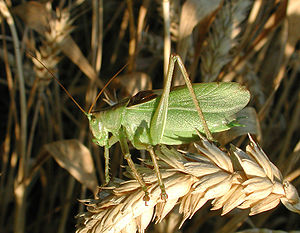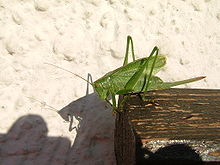Twittering horror
| Twittering horror | ||||||||||||
|---|---|---|---|---|---|---|---|---|---|---|---|---|

Twittering shrimp ( Tettigonia cantans ), ♂ |
||||||||||||
| Systematics | ||||||||||||
|
||||||||||||
| Scientific name | ||||||||||||
| Tettigonia cantans | ||||||||||||
| ( Füssli , 1775) |
The Locust or Zwitscherheupferd ( Tettigonia cantans ) is after the open Heupferd one of the largest in Central Europe occurring locusts . The male animals reach a body length of up to 30 mm, female animals are up to 35 mm long. The species is predominantly green in color and has elongated brown markings on the back. The ovipositor of the female protrudes well beyond the tip of the wings. Adult animals Tettigonia cantans occur from mid-July to October.
habitat
The twittering insect is moisture-loving, but also occurs on dry grassland . In terms of habitat it is quite undemanding and, like its sister species, lives on cultivated areas such as gardens and grain fields, in tall herbaceous corridors (preferably with bushes) and on sunny roadsides. She likes to sing at a height of 2–5 m.
distribution
In the north German lowlands, the twittering insect is quite widespread up to the coasts of the North Sea and Baltic Sea, but from the low mountain ranges to the south it is clearly montane and occurs almost nowhere below 300 meters above sea level, in the Alps it is usually only from 500 - 600 meters Encountered at altitude.
behavior
In contrast to its sister species, the chirping shrimp can hardly fly. She sings from noon until late at night. The loud singing (audible over 50 m) consists of stanzas that last a few (two to many) seconds and rise slightly in pitch. The individual syllables follow one another more quickly than in the case of the sister species, so that there is a rather rubbing-whirring noise. Usually some stanzas are sung with pauses of several seconds. In the evening the singing can change to a continuous tone. In the flatlands of the Elbmarsch (1–2 m above sea level), for example, both species occur in the same habitat, but Tettigonia viridissima is much more common (estimated 5 to 10 times). The chirping insect feeds mainly on insects, but also on plant-based food. It is very aggressive and also eats other grasshoppers, even the much larger green hay horse. The female lays the eggs in moist soil, whether open or overgrown.
literature
- Peter Detzel: Locusts in Baden-Württemberg . Ulmer Verlag, Stuttgart 1998, ISBN 3-8001-3507-8
- Schumprecht and Waeber (ed.): Locusts in Bavaria . Verlag Eugen Ulmer, Stuttgart 2003, ISBN 3-8001-3883-2


